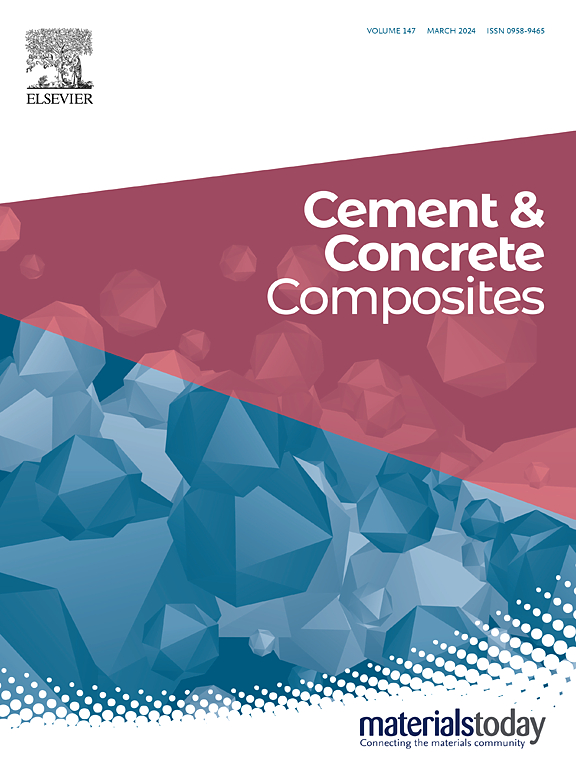预热聚对苯二甲酸乙酯纱线与纳米炭黑颗粒对砂浆高温性能的协同作用
IF 13.1
1区 工程技术
Q1 CONSTRUCTION & BUILDING TECHNOLOGY
引用次数: 0
摘要
研究了纳米炭黑(NCB)与普通纱线(YPET)和热处理改性材料(H-YPET)两种类型的聚酯(PET)纱线在不同温度下对砂浆初始力学性能和残余力学性能的影响。YPET与NCB在砂浆中的结合,减轻了NCB的团聚效应和YPET纤维增强砂浆(FRM)的弱抗压性能,而预热改变了h -YPET的表面性能,提高了砂浆的强度和热稳定性。含有NCB的YPET FRMs在室温下表现出优异的力学性能,抗弯强度(FS)分别提高44.8%(7天)和43.2%(28天),同时在高温暴露前后表现出与对照组相当的抗压强度(CS)。H-YPET FRM(不含NCB)表现出优异的热耐久性,28天的FS提高了19.5%,250°C加热后的残余抗弯强度提高了2.7%,250°C和400°C加热后的残余抗压强度分别提高了8.9%和15.8%,而在环境温度下的CS与对照组相当。本研究提供了两种具有优异机械性能和热稳定性的新型砂浆材料,为具有不同功能潜力的可持续建筑材料提供了有趣而有用的见解。本文章由计算机程序翻译,如有差异,请以英文原文为准。


Synergistic effects of preheated polyethylene terephthalate yarns and nano-carbon black particles on the mortar high-temperature performance
The effects of nano-carbon black (NCB) and two types of polyethylene terephthalate (PET) yarns, the general yarn (YPET) and the modified material with heat treatment (H-YPET), are investigated in regard to the initial and residual mechanical properties of mortar at various temperatures. The combination of YPETs and NCB in mortar mitigates the agglomeration effect of NCB and the weak compressive performance of YPET fibre-reinforced mortars (FRM). Meanwhile, preheating alters the surface properties of H-YPETs, improving the strength and thermal stability of mortars. YPET FRMs with NCB present superior mechanical properties at ambient temperature, improving flexural strength (FS) by 44.8 % (7 days) and 43.2 % (28 days), respectively, while demonstrating comparable compressive strength (CS) to the control before and after high temperature exposures. H-YPET FRM (without NCB) present superior thermal durability, enhancing FS by 19.5 % at 28 days, residual flexural strength after 250 °C heating by 2.7 %, residual compressive strength after 250 °C and 400 °C by 8.9 % and 15.8 %, respectively, while demonstrating comparable CS to the control at ambient temperatures. This study provides two novel and promising mortar materials with outstanding mechanical properties and thermal stabilities, contributing interesting and useful insights towards sustainable building materials with the potentials to possess different functionalities.
求助全文
通过发布文献求助,成功后即可免费获取论文全文。
去求助
来源期刊

Cement & concrete composites
工程技术-材料科学:复合
CiteScore
18.70
自引率
11.40%
发文量
459
审稿时长
65 days
期刊介绍:
Cement & concrete composites focuses on advancements in cement-concrete composite technology and the production, use, and performance of cement-based construction materials. It covers a wide range of materials, including fiber-reinforced composites, polymer composites, ferrocement, and those incorporating special aggregates or waste materials. Major themes include microstructure, material properties, testing, durability, mechanics, modeling, design, fabrication, and practical applications. The journal welcomes papers on structural behavior, field studies, repair and maintenance, serviceability, and sustainability. It aims to enhance understanding, provide a platform for unconventional materials, promote low-cost energy-saving materials, and bridge the gap between materials science, engineering, and construction. Special issues on emerging topics are also published to encourage collaboration between materials scientists, engineers, designers, and fabricators.
 求助内容:
求助内容: 应助结果提醒方式:
应助结果提醒方式:


